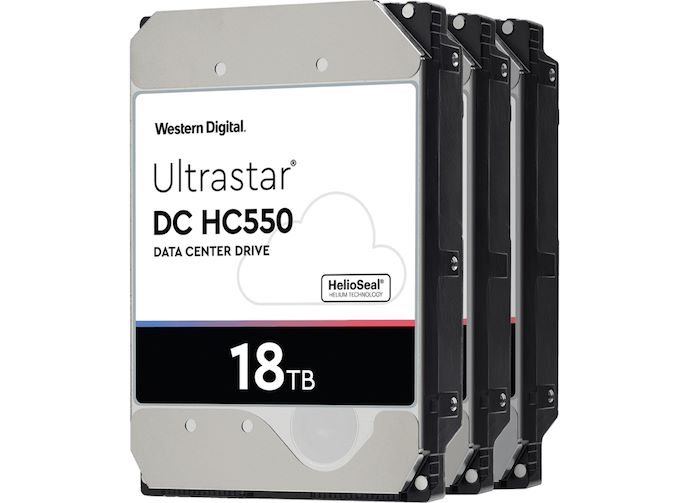Western Digital: Expect More Energy-Assisted Tech For 24 TB & Beyond
by Anton Shilov on December 12, 2019 6:30 PM EST- Posted in
- Storage
- HDDs
- Western Digital
- MAMR

Western Digital has been promoting its microwave assisted magnetic recording (MAMR) technology for over a couple of years now, yet surprisingly, its upcoming 18 TB and 20 TB drives are not really using the tech. The reason for this lies in the company's decision to use what they consider to be the right technology at the right time. To that end, Western Digital not only plans to use MAMR in the future, but is open to use heat assisted magnetic recording (HAMR) technology when time comes.
Energy assisted magnetic recording (EAMR) technologies will enable future nearline hard drives with extreme capacity and areal density, there are no doubts in the industry about that. But HDD manufacturers have different opinions about when to introduce these technologies. Seagate believes that heating the platters using laser (HAMR) is the way to go now, whereas Western Digital is confident that using microwaves to change their coercivity (MAMR) better for the foreseeable future. And both agree, at least, that in the long run HAMR will enable a higher areal density.
Having invested an ample amount of R&D money into various EAMR technologies, Western Digital discovered that transition to HAMR is a hard one as it requires the introduction of new heads as well as use all-new platters, whereas MAMR needs new heads and slightly different platters. While working on MAMR, Western Digital found that it was possible to only partially implement the technology and still get the desired result – an increase in areal density. In fact, the company’s Ultrastar HC550 HDDs (and 20 TB drives) will be the first products to use this type of EAMR technology that is currently called energy-enhanced PMR (EPMR).
According to Western Digital, EPMR is particularly easy to incorporate into hard drives, especially considering the fact that it does not use a spin-torque oscillator, which is a key element of Western Digital's MAMR technology.
And while EPMR has changed Western Digital's roadmap slightly, at the end of the day the company says it hasn't changed the development philosophy: the various magnetic recording technologies that they're researching will be used once they are needed to hit certain capacities. For the moment, then, the company has indicated that they're looking at their options for 24 TB and 30 TB drives, and what they'll need to do to make those capacities practical.
Here is what Siva Sivaram, president of technology and strategy at Western Digital, said at the Wells Fargo Technology, Media and Telecommunications Summit earlier this month:
“The 18 TB product that is going out this December will use a variant of the MAMR technology. We are agnostic as to which technology we will have to succeed in the long term. We will introduce the right technology at the right point when it gets to 24 TB and 30 TB. We see a path to get to 50 TB in our hard drive roadmap. As we go to 50 TB, we will introduce the right technology at the point when it actually makes sense.”
Related Reading:
- Western Digital Reveals 18 TB DC HC550 'EAMR' Hard Drive
- 16 TB MAMR Hard Drives in 2019: Western Digital
- 18 TB HDDs: Toshiba Collaborates with Showa Denko for MAMR HDDs
- Western Digital Launches Ultrastar DC HC530 14 TB PMR with TDMR HDD
- Western Digital 20 TB HDD: Crazy Capacity for Cold Storage
Source: Western Digital (via Blocks & Files)










11 Comments
View All Comments
azfacea - Friday, December 13, 2019 - link
I am highly skeptical these technologies (HAMR, MAMR, EAMR) are ever going to work right. its all talk and nothing real. If it quakes like an intel 5g modem, talks like intel 5g modem, walks like intel 5g modem, maybe it is the intel 5g modem. LULedzieba - Friday, December 13, 2019 - link
No reason it can't work, Magneto-Optical media is hardly new.bigvlada - Friday, December 13, 2019 - link
Steve Jobs used it in the first Next Cube machine as a boot drive which crippled the performance. After that fiasco Next Station used proper HDDs.wolfesteinabhi - Friday, December 13, 2019 - link
when do we get to store our data and movies on DNA based drives??rahvin - Friday, December 13, 2019 - link
Do you really want to have to inject sucrose into your hard drives to keep them working?PeachNCream - Friday, December 13, 2019 - link
It will be cool when MAMR means magnetic assisted magnetic recording and then WD will not have to change heads or platters at all to use the technology.mode_13h - Saturday, December 14, 2019 - link
If you're going to be silly, why not Magnetic-Assisted Microwave Recording?Supercell99 - Monday, December 16, 2019 - link
2020 is HAMR time, MC Hammer will be collaborating with Seagate and Jay-Z with something special, stay tuned.3DoubleD - Tuesday, December 17, 2019 - link
I for one just hope we can break the streak of stagnant HDD prices we've been suffering for the past 5 years. Some actual better technology could possibly go a long way.Either that or SSDs catch up in the next 5 years and we don't have to worry about using spinning rust anymore! And I'm perfectly fine if it is QLC NAND. Come on 8 TB SSD for less than $300 CAD...